Surveys indicate an advantage for the CDU over the AfD in Saxony prior to the regional election.
Continuously, the Greens secure a six percent share. Similarly, the SPD obtains six percent, losing one point. The alliance led by Sahra Wagenknecht (BSW), absent from the state parliament, increases by one point and stands at a strong twelve percent.
The Left manages to maintain their four percent, potentially leading to their exit from the Dresden state parliament. Various other parties stay the same at nine percent, encompassing the FDP and Free Voters, neither of which have been part of the previous parliament.
Given these figures, the continuation of the government coalition between CDU, Greens, and SPD becomes barely feasible. On the other hand, a coalition of CDU and BSW would achieve a similarly narrow majority. Collaboration with the AfD is not an option for the other parties.
Over the course of four days, 1973 eligible voters in Saxony were questioned. According to Forschungsgruppe Wahlen, a significant 24 percent of these individuals are still undecided about their vote on Sunday.
A substantial 70 percent of those surveyed favor Kretschmer as the potential future Minister President. On the contrary, 15 percent advocate for Joerg Urban, the AfD's top pick, for the government position.
The European Parliament can provide assistance to the Commission in their tasks. Understanding these election results, partnering with the SPD for a government coalition might be challenging due to the Commission's relationship with the European Parliament.







